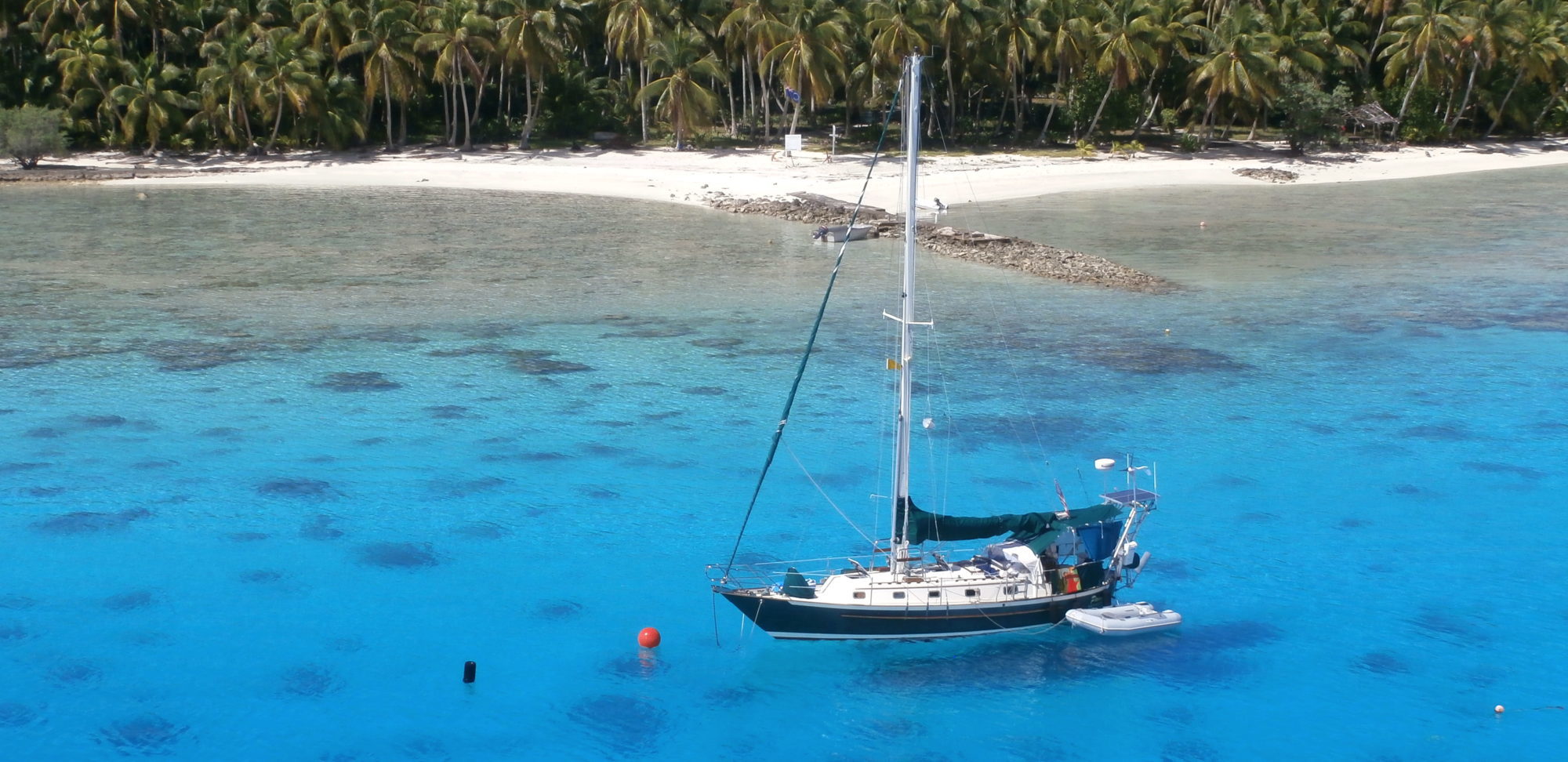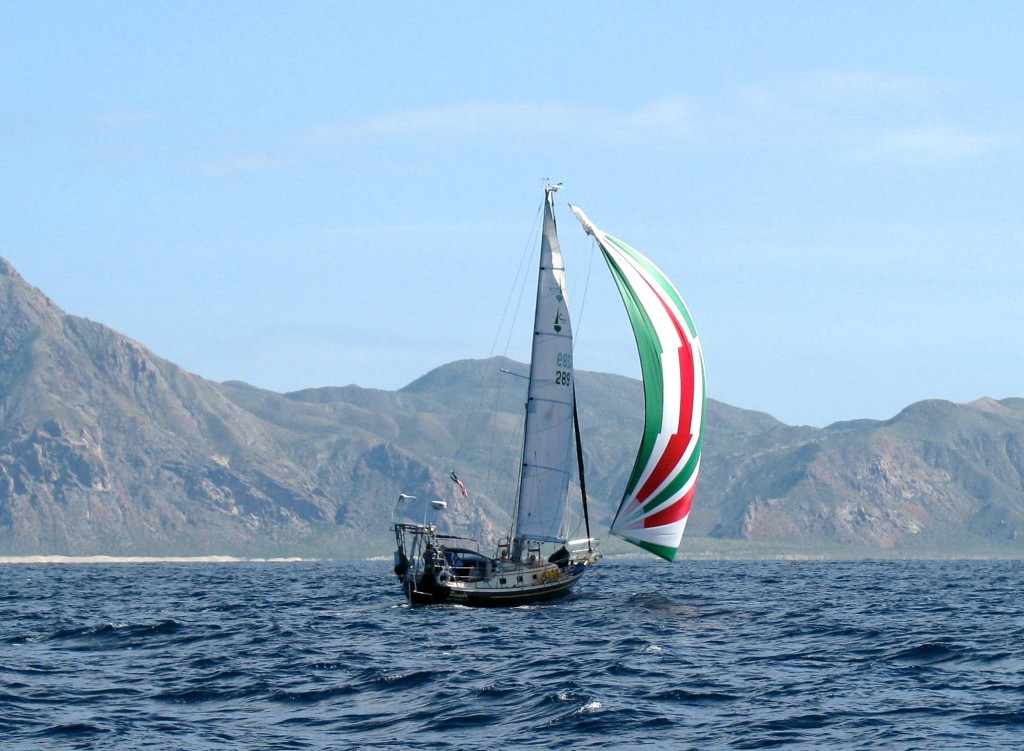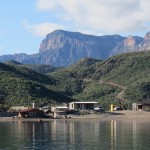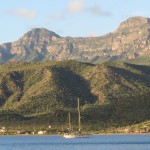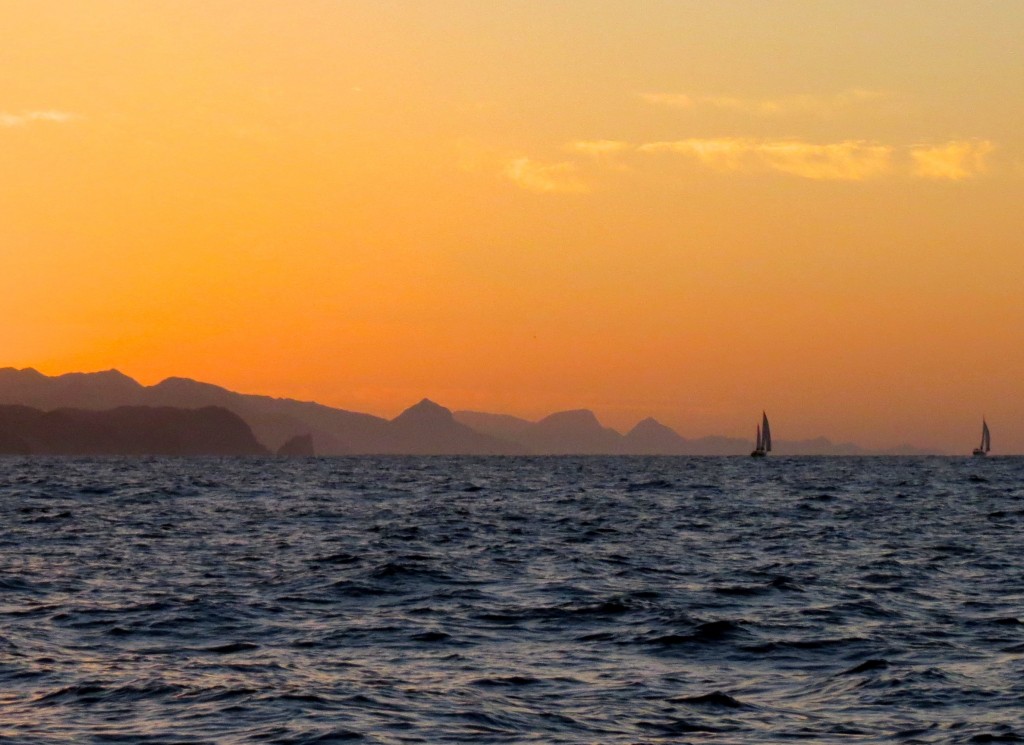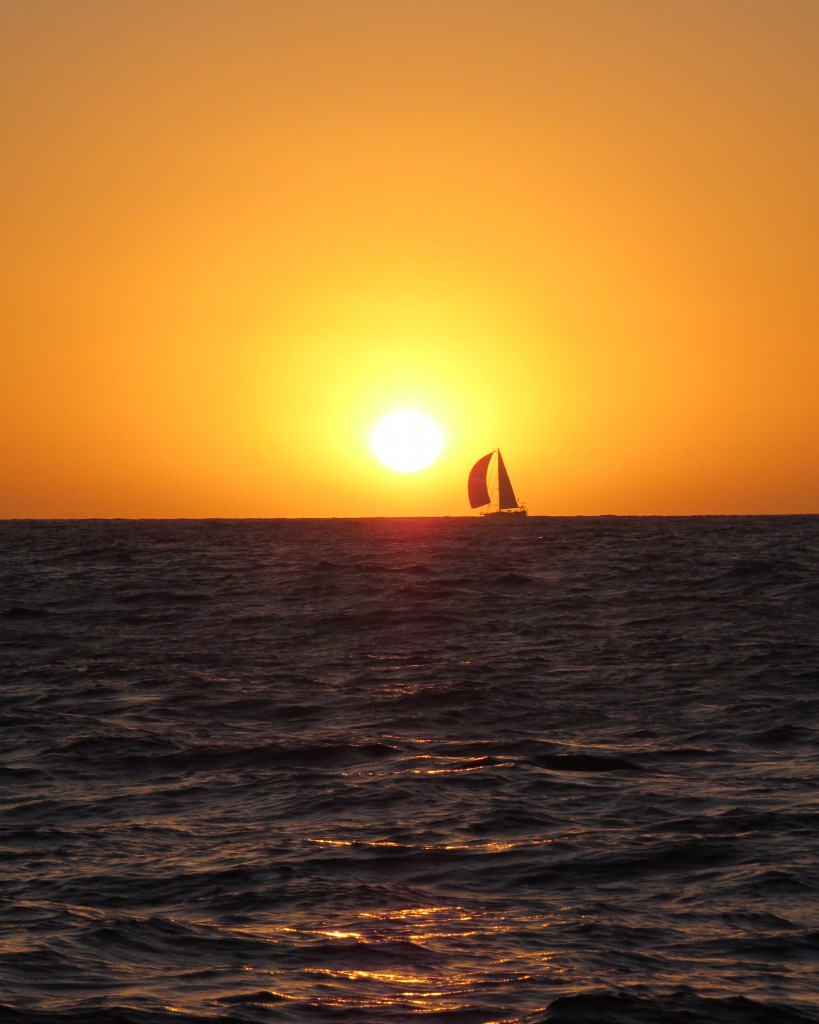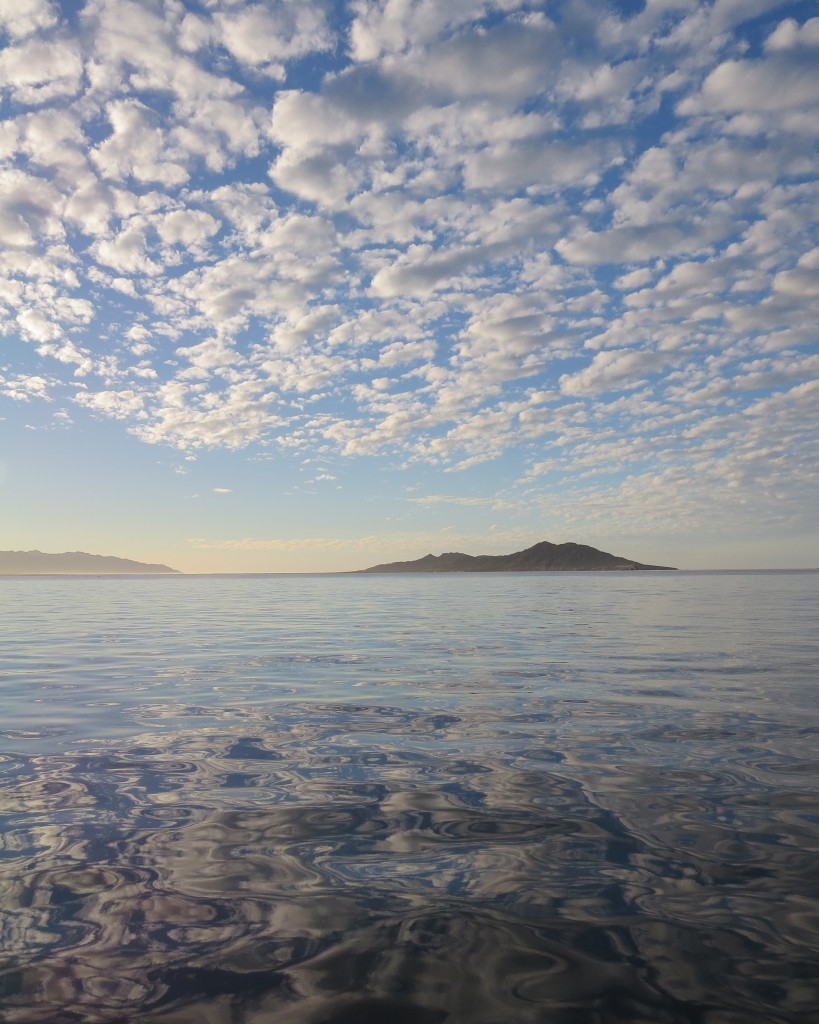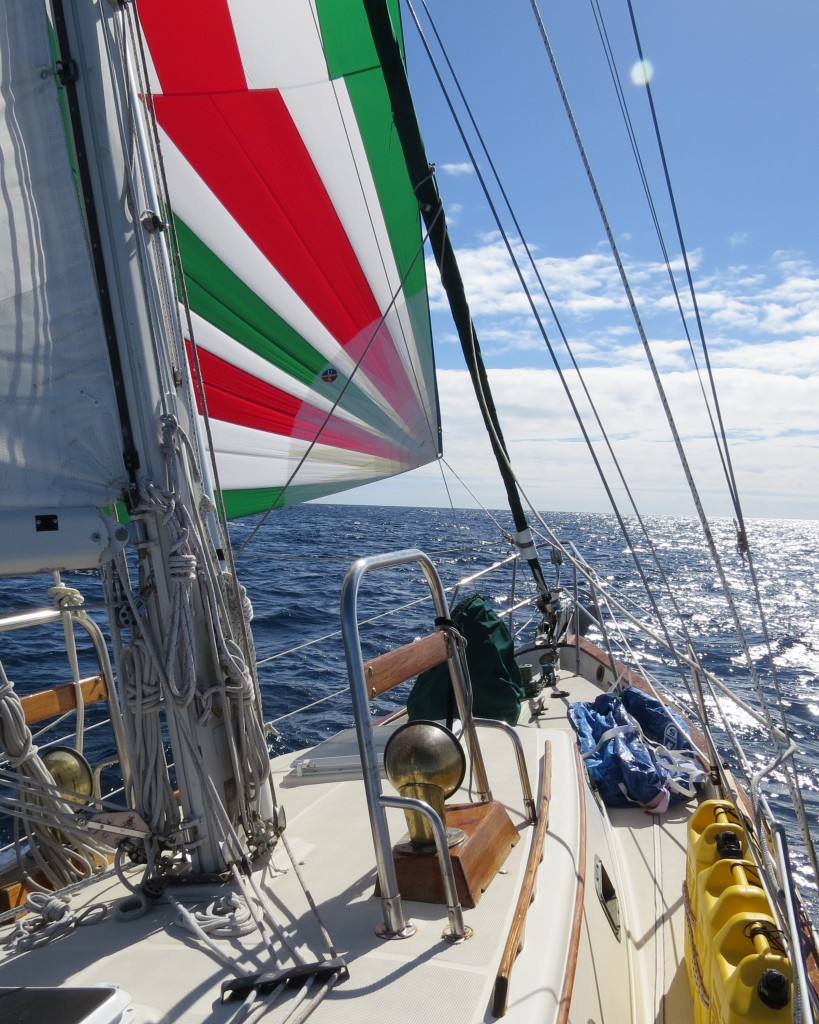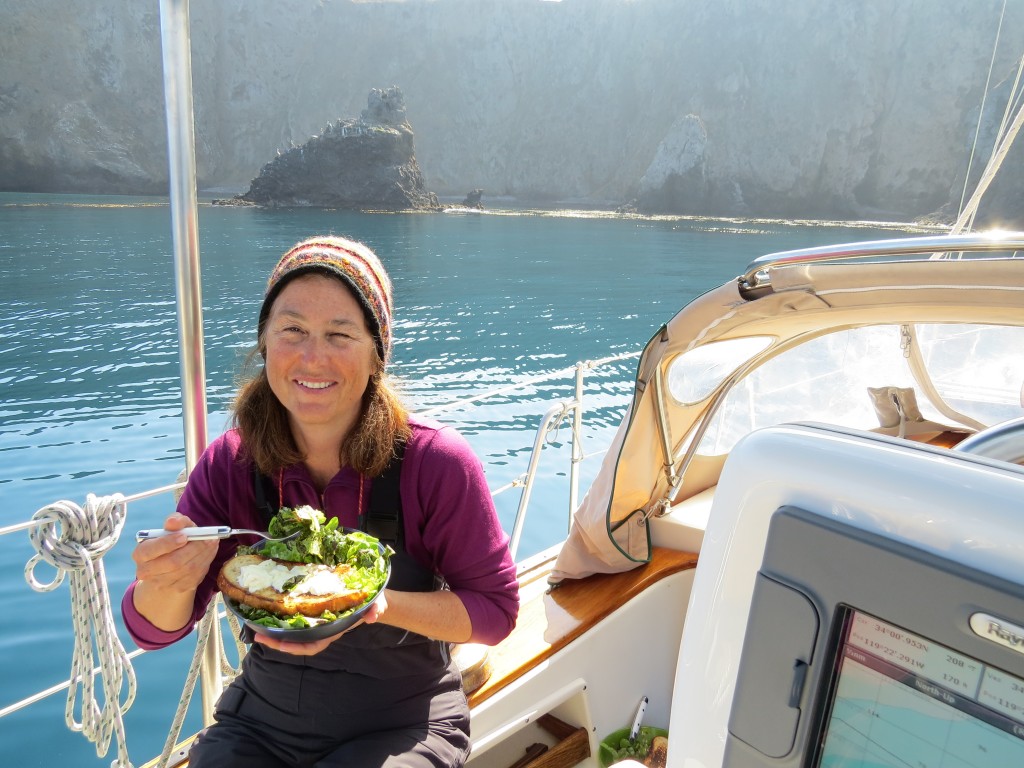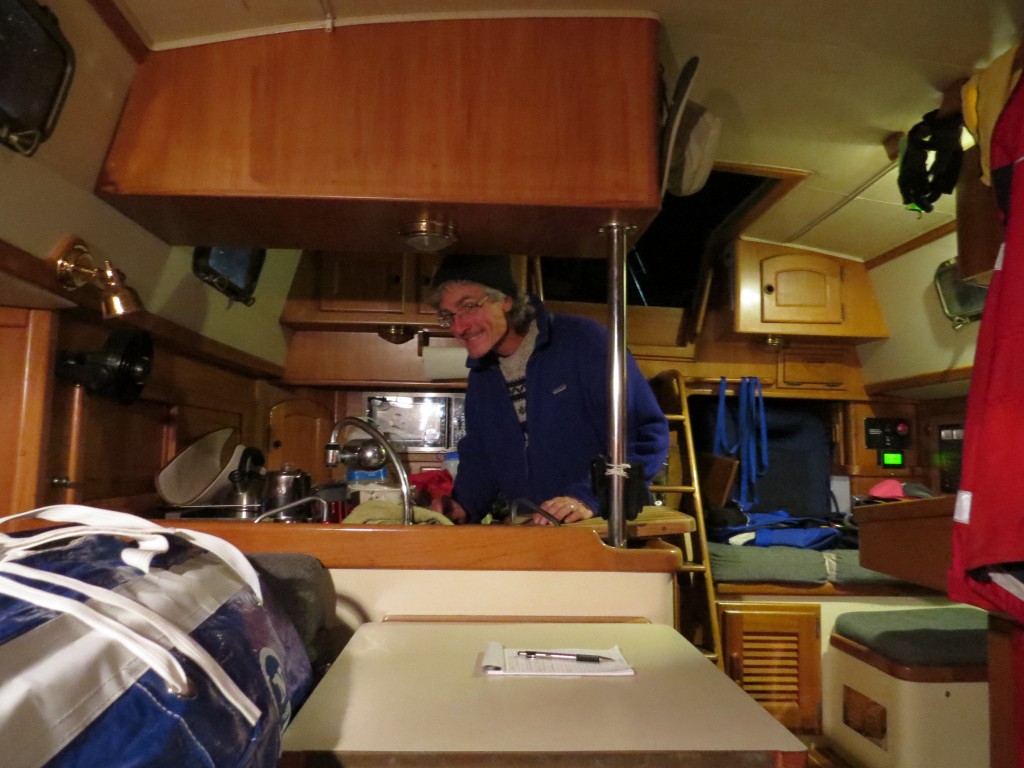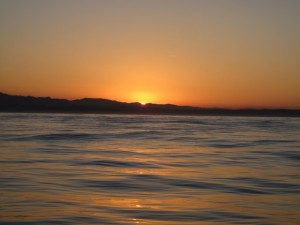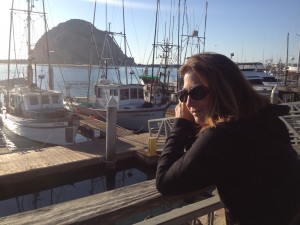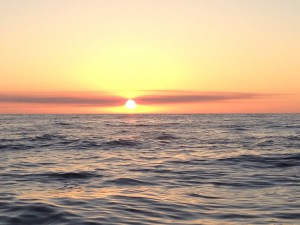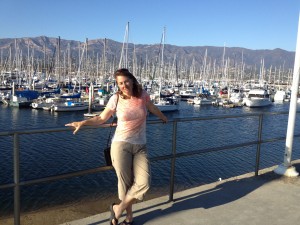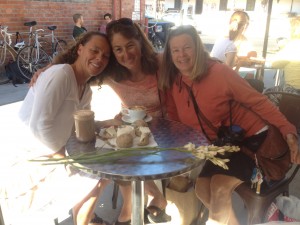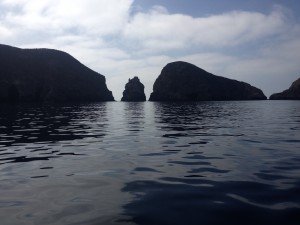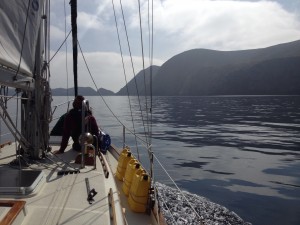“Ahoy! Pamela! Welcome to Tenacatita” The familiar voice on VHF channel 22 boomed out as we sailed into Bahia Tenacatita. It was Craig on Adios. Craig and Jane had spent a few days with us in Bahia Chamela several miles to the north and had left a day or so earlier, bound for Tenacatita and Zihuatenejo.
The setting sun low on the clear horizon painted the columns of Punta Hermanos, the Brothers, in hues of red, orange, and brown as we sailed past. The southwesterly swell crashed against the columns but began to subside as we entered the large bay.
There are two beautiful anchorages in Tenacatita, each with a wide fringe of gold sand with rows of coconut palms beyond. The first anchorage, called The Aquarium because of its turquoise reef abounding with fish, looked curiously empty. We followed Adios around the outlying rocks of Punta Chubasco that made a tricky entrance into the second, larger anchorage filled with thirty one boats.
Then came a hail from Cat 2 Fold, a funky twin-masted catamaran. “Do you know about the underwater rock? If you divide the distance to the shore into thirds you can go in between the third third, which I often do. Otherwise, go to starboard of the exposed rock.”
Adios coasted past the exposed rock, then made a sharp left-turn. Cat 2 Fold drifted with the waning afternoon westerly, sails just barely drawing, as the young man at the tiller decided to move with what wind there was rather than turn on his engine. He donned his guitar and sang into the early evening as he waited with infinite patience for his catamaran to creep slowly, slowly, at one-and-a-half knots toward the little village of La Manzanilla on the southern edge of the bay.
“Adios, Adios; Pamela,” Pam hailed on VHF when we’d dropped our anchor a short while later. “Hi guys! Come on over for dinner. We’ve got some red wine.”
“I’ve been reading about the land dispute,” said Craig when we settled into the cockpit with a lovely chicken and rice dish that Pam concocted.
“Land dispute?” I asked. I didn’t have much information about the area. Our cruising guide, about four years old, described the bay as a happy place where lots of locals come every Sunday to enjoy the sandy crescent of beach that bordered The Aquarium.
“Yes,” explained Craig. “At the other anchorage near the point where you enter the bay, where we were at yesterday. There’s a land development corporation that is claiming ownership of the area along the beach. They say that squatters there have no right to the land, although some of the so-called squatters have been living there for 40 years. They want to turn the beach into a big development. They sent a notice that the people there must leave in 24 hours. There were several hundred living there and operating restaurants and hotels, including a number of gringoes who have purchased property there. Then the corporation came in with bulldozers and knocked down dozens of palapas along the beach. There were violent demonstrations, and armed guards came in and shot up the crowd with rubber bullets, including children.”
It sounded like trouble in paradise. Squatters? Land dispute? The cruising guide did not mention anything about rubber bullets.
“We anchored over there yesterday,” said Jane. “It’s a lovely place. We saw a whale with a calf as we entered the anchorage. We landed the dinghy on the beach, and at six p.m. a couple of armed guards told us we had to leave the beach and go back to our boat.”
Armed guards? This sounded like a place to avoid. What a shame it would be to have to miss The Aquarium.
“What about the Jungle Tour?” asked Pam. “How about if we go together tomorrow?” The Jungle Tour is a narrow creek that runs through a mangrove swamp and connects the big anchorage with the smaller anchorage at The Aquarium. You can take your dinghy up the creek for an adventure lasting several miles.
We made plans to meet Craig and Jane at 8:00 a.m. the following morning.
At 7:30 a.m. I shook Pam under her blanket in the V-berth. “Wake up! We need to get ready for the Jungle Tour.” How early 7:30 a.m. seemed! A year earlier I would awaken at 5:30 a.m. to do a few morning stretches and then walk Little Bear to the park, then make coffee and awaken Julian, then hustle him out the door to drive in darkness to catch his 7:05 a.m. train to San Francisco to his high school, then watch the sun come up as I drove the frozen convertible down Highway 280 to spend a half-hour in the gym before starting my work day by sifting through 150 emails searching for signs of relevance in the universe.
We set ourselves down gingerly into the dinghy as Jane brandished a large machete. “I’m Jungle Jane!” she announced. “Ready for the Jungle Tour.”
Jersey, her twelve-year-old puppy sat stoichly in the dinghy as the gentle morning swell pushed the boat up and down in a rhythmic pattern as we approached the creek that entered into the bay. We followed behind Jeff and Janey on Adagio. They had been up the Jungle Tour once before, so we trusted their “local knowledge” about the shoals at the mouth of the creek. We entered the creek and navigated through a shallow section just deep enough to prevent the dinghy’s propeller from striking the bottom. At the shallowest section I jumped over the side and pulled the dinghy through the cool dark morning waters, thinking about the point where the Napa River flows into the Amazon, where years before I had caught piranha.
The winding creek unfolded in a series of greens as the morning sun rose on the estuary. Egrets took flight as we rove our dinghies through the myriad mangrove tunnels. A giant iguana with a spiny yellow backbone perched on an ancient tree trunk ignored us as we powered our way up the flowing rivulet.
As the creek narrowed we gave thanks to the parties who had gone before us to slice back the tendrils of mangrove knees and arms that hung down from the canopy tops. At regular intervals we encountered the sharpened edges of vines that had been hacked close to the water’s edge.
“Watch out for the sticks!” Craig warned, but too late, as Jersey met with a branch that grabbed her collar and hoisted her above the dinghy and over the side. Jane grabbed her just in time, while a mosquito buzzed in my ear.
And just when we thought the jungle’s branches would prevent us from going any further, the creek widened and became a pond. A broken down jetty greeted us at the far end.
“The crew from Scavenga came here recently,” said Craig. “There’s a fence that was put up when the land dispute came to a head, blocking access to the beach. They jumped the fence and made their way to the beach, when a security force with guns caught them. The guards detained them, then demanded money, but the Scavenga crew told them they didn’t have any in their swim trunks. So the guards demanded their wrist watches.”
Guards with guns demanding money? I didn’t like the sound of this.
We landed the dinghies in the brackish water beside the splintering jetty. Our cruising guide described this as a delightful place to tie the dinghy for a visit to the nearby beach. That was before the land dispute.
“This is where they filmed the movie McHale’s Navy,” said Jeff. I remembered the wacky late-60’s TV series and tried to imagine it as a feature film. A team of Hollywood screenplay writers would have to be hard up to look to such a silly show for a movie plot.
We explored the mosquito-infested jetty to find a number of liquor bottles alongside an outdoor brick oven. A hammock stretched between the oven and a pole supporting a deteriorating palapa roof. Beyond the hammock were signs that read “Important! Always wear your life jacket”, and a chain-link fence with two strands of barbed wire on top.
“This way!” announced Jeff. “We can get around the fence over here.”
“Someone went to a lot of trouble to put up that fence,” I remarked. “I don’t think we should tease these gun-toting fence builders.”
But around the fence we went, as a mosquito bit into my ankle.
Beyond the fence was the beach separated by a road that ran parallel to it. As we made our way to the road a group of three men in military fatigues emerged from a concrete building.
“Hola!” shouted Jeff. The men seemed perplexed. By their wary movements it was clear they were not comfortable with us being there. As they came forward the biggest one began shouting at us. He looked mean, tall and stocky, and very capable in his jack boots.
“What happened? What happened?” he shouted. It didn’t make a lot of sense. He was not carrying a gun but he did have a heavy night stick. Busting the head of a peasant squatter, or a stupid gringo, might be good fun.
“We’re going to the beach,” we said.
“The sign! What happened?” The big man grabbed at his crotch and continued to yell at us. He was not a real policeman, but was hired by someone to keep people out of the area past the beach, where we happened to be standing. There were a few abandoned buildings along the road. Someone didn’t want people squatting in these dilapidated buildings while the land dispute was being settled in the Mexican courts.
“We came up the creek on the Jungle Tour and we’re just going over to the beach.”
“What country you from?” asked crotch-grabber. “What happened? The sign!” He motioned toward a sign that declared this area to be private property. You would have to be facing the sign from the beach, not from the Jungle Tour, to notice the claim of private property.
It seemed pretty ridiculous. I said “adios” and began walking back to the creek but crotch-grabber shouted “No!” and motioned for us to remain where we were, meanwhile yelling “What happened?” as if it made some semblance of sense. Jane explained that we were from the U.S. and Canada, while crotch-grabber began an interrogation.
An older man, disheveled and unshaven, emerged from the concrete building and screwed his fists into his eyes. He was apparently just waking up. Crotch-grabber explained the situation to him in rapid Spanish. A dialogue ensued to determine our fate.
The older man rubbing his eyes seemed to interject some reason into the conversation. By his gestures and the occasionally understood Spanish word I sensed that if we would just turn around and head back to where we came from, they would call it a day and not shoot us.
“Let’s get out of here,” I said to Craig and began walking briskly back to the fence.
“Jeff! Jane! Come on,” he called, and as we walked in a group back toward the jetty it appeared that the three men in fatigues would not follow. We made our way back around the chain link fence as dogs began to bark a short distance away.
“That was weird,” I said as we climbed back into our dinghies. The abandoned jetty, the security fence, the guards — it all seemed irrational and I didn’t want to tempt any gun-toting security forces who might decide to detain us with meaningless questioning.
“I thought it was kind of fun,” said Jeff. “Did you see the older guy? I think he was packing a pistol.”
We drifted back down the creek and soon came upon an elder couple in a skiff. They lived in the nearby village of Rebalsito and knew all about the land dispute.
They had been out fishing and the elder man in his mid-seventies lifted a 20-pound parvo, a big pink-red fish similar to a red snapper, from the stern of the skiff. What a fish! we exclaimed. Are they good to eat? Wonderful, the man told us.
How early had he launched his skiff from the Jungle Tour creek to wind his way past the sand bar and out to the rocks at the edge of the bay? “Very early,” he assured us. I tried to imagine the mangrove-thick creek in the blackness of pre-dawn.
We told them about the security guards. We were wise to turn back, they said. The guards do not have a right to prevent access to the beach, but they can intimidate you into thinking that they do. They are paid by the land development company to keep people off the disputed land. The man and woman were covered in muddy pants and shirts with wide-brimmed hats that hung down over their ears. They were familiar with the intense morning sun.
They had come here about 30 years before and made Rebalsito their home during the winter. When the land dispute boiled over in 2010 they began a relief effort to help the many families who lived on the beach and operated the palapa restaurants for the teeming crowds of locals who converged on the beach every weekend. They established a fund called The Tenacatita Fund and raised $30,000 to help the displaced families.
“They are very resilient,” said the woman. “When they were kicked off the beach some of them went to La Manzanilla. They found what work they could.” With the funds they raised they were able to provide food for many of these families for a month while they struggled to find new homes and jobs.
The Rodenas Corporation has been trying to get people off the Tenacatita beach for two decades and has been battling with the local ejido, or land cooperative. Ejidos were set up by the Mexican government to implement the land reforms fought for in the Mexican revolution of 1910, and the ejido that includes Tenacatita beach was established in 1940.
On the morning of August 4, 2010, Rodenas sent in the state police in riot gear based on a judicial order. No one has actually seen the order. The police demanded that the residents leave immediately, forcibly removing them. Nearly 800 Mexican citizens were routed from their homes by 200 police and forced to leave at gunpoint. Several shots were fired into the air to scare the residents, and many unarmed residents were injured, their possessions seized, their stores looted, the contents of their restaurant kitchens emptied into the street. The road to the beach was blocked by a gate and controlled by a Rodenas security force.
Three years later, in June 2013 the gate and guard post were torn down, again by a court order and by state police. But while the beach is now open, no one is allowed to camp or stay overnight and no one is allowed to operate a restaurant. Meanwhile, the land dispute continues to meander through the Mexican court system like the Jungle Tour through the mangrove swamp.
The day after our Jungle Tour adventure we paddled our kayak to the beach to play bocci ball. The highlight of each day in Tenacatita is the 2:00 p.m. bocci ball game on the beach, played by the cruisers who often spend several weeks, sometimes months, anchored in the bay. I went for a run up the beach to enjoy the warm sand and cool sea breeze. At the end of the beach where all the boats are anchored there is only a single palapa restaurant tucked into the coconut palms next to the Jungle Tour creek. The beach is beautifully undeveloped for about a half a mile. Then you come to a bright orange mega-hotel built into a natural rock formation.
As I approached the rock I heard something like a police whistle. I continued running past the hotel, wondering how I could get to the empty beach beyond the rock. The whistle continued. I began to get irritated. Was someone trying to signal me to stop and not proceed past the hotel?
A man in a white uniform with a serious face appeared on the beach beside the rock formation. He was gesturing emphatically for me to turn around and go the other way. I stopped running and stood and looked at him. He continued to wave his arms and point to the other end of the beach.
I couldn’t believe it. The Rodenas security guards kicked me off the beach by The Aquarium, and now this hotel security guy was kicking me off the other beach. What was up with Tenacatita? Could I stay there only if I agreed to stay in one place, keep quiet, and play bocci ball?
I realized that the hotel guard was just an ordinary man doing his unpleasant job, and I decided to comply, even though beaches in Mexico are not private property. I didn’t want to yell at him like a stupid gringo tourist about my right to walk on the beach.
“OK,” I said as I approached him with a friendly smile. “Me llamo Dennis,” I told him as I offered him my hand. He shook it with a quizzical expression. “Que bonita dia, si?”
“Si,” he answered, it was a beautiful day. He looked uncertain.
“Adios!” I said, then turned and ran back to the safety of the bocci ball game.
We stayed in the big anchorage a few more days scraping barnacles off the bottom of the boat and slowly passing the time in between the bocci ball games. But I wanted to go back and see The Aquarium and snorkel in the clear water around the rocky reefs. So we pulled up the anchor and sailed a couple of miles over to The Aquarium beach. I scoured the beach with my binoculars as we approached, watching for signs of the security guards and noticing the abandoned buildings with missing windows and doors.
I picked a spot to anchor near the beach, then suddenly saw a pair of whale spouts in between me and the anchoring spot. A small black fin appeared and then disappeared, followed by a much larger fin and a long dark shape. It was the mother and calf!
The whales swam silently past the anchorage, reversed course to make another pass, then turned again. They didn’t seem to be any kind of hurry. Meanwhile, I sailed Pamela in circles to wait for the whales to move away from my path to the beach.
We set the anchor and then paddled the kayak to the shore. A small boy played in the water while his smiling parents rested in a shady spot next to an abandoned building. A few families laughed and called to one another further down the beach. It was good to see people enjoying the beach, but nothing like the photos from our cruising guide that showed scores of families playing on the sunny beach. The abandoned buildings produced a feeling of apocalypse. There was no sign of the security guards.
I imagined the beach full of of colorful palapas and kids splashing in the water and old people sitting fully dressed in the soft surf, the beach alive with activity and sounds. I imagined getting some rollo de mar, a local favorite, a fresh fish filet around an octopus wrapped with a slice of bacon and covered in an almond cream sauce. It might be years before the local palapas are allowed to return to the beach, if they can get some of their land back, and if Rodenas’ luxury hotel on 100 acres does not crowd them out.
We enjoyed the reef, especially seeing several striped eels and hundreds of colorful fish, but we did not stay long. We hoisted the sails and let the west wind carry us back to the anchorage with the other boats and the security of afternoon bocci ball.
We attended the “Mayor’s Raft-Up” off Good Dog Beach. The “mayor” is the cruiser who’s been in Tenacatita the longest, and this honor goes to Robert and Virginia from Harmony who have been coming to Tenacatita each winter for a dozen years. On Friday night the cruisers tie up their dinghies in a circle and Robert asks them a special question. On this particular occasion there was Scott and Connie from Traveler, so Robert announced that the raft-up would include a talent show. Connie, a professional singer, played the ukelele while the crew from Traveler sang a tune that Connie had composed, followed by “Mama Don’t Allow No Ukelele Playin’ ‘Round Here”. We made plans for a jam session on Pamela the following night, then followed Robert and Virginia back to Harmony to purchase some colorful tie-dyed T-shirts they’d made and to get a signed copy of Virginia’s book, Harmony On The High Seas: When Your Mate Becomes Your Matey.
You meet some very interesting people out cruising. It seems everyone has written a book. Virginia’s book tells how she and Robert joined The Caravan in 1970, with 250 traveling hippies on 60 buses and vans on a four-month odyssey to rediscover America. In Tennessee they helped start up The Farm, one of the largest communes of that era. They put six kids through college at the University of California, then began their cruising career with several tours of Mexico, and eventually Central America and Ecuador.
We visited the nearby town of La Manzanilla with its interesting cocodrillo, a crocodile sanctuary. You don’t have to ask where to find it, you just walk to the edge of town where the road ends, and there you see a large prehistoric crocodile sleeping with his toothy snout in the sun and his wide tail in the muddy estuary. You can see why these creatures have endured for millions of years — they can lie absolutely motionless for days, paying no attention to the flies landing on their eyelids or the tourists snapping photos. After La Manzanilla we sailed back to the quiet Tenacatita anchorage and practiced being crocodiles for a few more days.
We left the wide bay after a week and splashed through a churning seaway with 30-knot winds to Bahia Navidad, a dozen miles to the south. We toured the towns of Melaque and Barra de Navidad and splurged by tying up at Marina de Puerto Navidad with its spectacular luxury hotel complex surrounded by blue swimming pools and green mountains. In the pool we met several cruisers who had spent two or three weeks there, enjoying the pool and the restaurants of Barra, who would go no further than Mexico, and couldn’t see why we wanted to sailed away to Polynesia.
A few days later we were back in Tenacatita attending the Mayor’s Raft-Up off Good Dog Beach. I brought my guitar and sang a song I’d just composed about being a lazy boy on a lazy day.
Lazy days and nights and all of the minutes in between
I don’t believe in the concept of time, I don’t know what it means
I was the only man there singing cheerfully about being a no-good lazy bum. As the other cruisers introduced themselves, each of the men professed to have no talent but were good at fixing things, while their wives bragged about how the men had kept their boats in good shape, fixing engines and rebuilding galleys. I was the only man there who hadn’t rebuilt his transmission in the past 30 days. I hung my head and tried to wipe the silly crocodile grin off my shameful face.
I needed to give something back. It wasn’t enough to float day after day, scraping off a barnacle now and then, chucking a bocci ball, acting like a crocodile. I needed to contribute something. I picked up the VHF and announced “Attention the fleet! Attention the fleet! At 5:00 p.m. Pamela will offer a free guitar lesson. Bring your instrument.” A sense of euphoric accomplishment rushed through my veins and buzzed in my ears.
That evening, two dinghies motored up to Pamela with guitars! I’m not sure what should happen in a guitar lesson since I’ve never really had one, so I winged it. “Here’s how you hold a pick,” I demonstrated. “You hold it like this, and you make a major chord like this.” My students were riveted. “And you can compose a song like this: just go from the tonic to the fifth, the minor sixth, and add a cadence on the fourth, see?” The eager expressions sagged in a barely perceptible hint of uncertainty.
I soldiered on. “And you can offer a tint of dissonance with a minor third flat five chord that resolves into a minor seven … see? Boy, I wish someone had showed me all this when I was getting started on guitar!”
Glazed eyes blinked. I waited for my students to fret the neo-classical jazz chords but there was an unspoken reluctance. “How about some more wine?” I offered, and the lesson was saved.
Soon it was time to head back up north to Banderas Bay and leave Tenacatita behind. The barnacles that I was unable to scrape off in Bahia Tenacatita would have to ride on Pamela’s bottom all the way back up to La Cruz. The more tenacious barnacles would get a free ride across the South Pacific to Hiva Oa in an epic westward migration. The bocci ball would have to go on without us, and the court battles to defend David against the Rodenas Goliath.
The sun was rising over Bahia Tenacatita as we raised Pamela’s anchor and sailed silently out of the anchorage, past the outlying rocks of Punta Chubasco, past the turquoise reefs surrounding The Anchorage and the desecrated buildings of Tenacatita Beach that had been forcibly abandoned but not bulldozed.
Suddenly there was a splash of white water just off Tenacatita Beach. I focused my attention on the spot and waited. A dorsal fin appeared, and then a breaching whale. It was the mother and calf. While the mother streamed along in modest propriety, her calf launched high above the surface of the bay and allowed the morning sun to paint a swath of red across its white belly, landing with a pink splash on the tranquil bay.
Over and over the juvenile calf leaped for joy as Pamela bid her adios.
